
Normanhurst Court was a large manor house in the village of Catsfield in East Sussex.

Normanhurst Court was a large manor house in the village of Catsfield in East Sussex.
The building of the house was initiated by Thomas Brassey, one of the leading railway builders of the nineteenth century. [1] The works, which were carried out by Lucas Brothers, [2] were completed shortly after he died in 1870 [3] and the house was occupied by Lord Brassey, his son. [1] The house was designed to resemble a French Chateau, and was home of the Brassey family for many years. [1]
The house contained some important portraits by Walter Goodman of Lord Brassey, his wife, Lady Anna Brassey, their children, and Thomas Brassey senior. [4]
It was approached by two entrances each with a lodge. [5] An octagonal water tower rose in the South-West corner of the site. [5] The water tower, a museum and the bachelor's quarters were all situated away from the main building. [5] The estate extended to some 3,400 acres (14 km2) with farmhouses and other buildings. [5]
During World War I it was used as a military hospital for wounded soldiers and, then having been used as a girls' school between the wars, [6] it was used as a Prisoner of war camp during the Second World War. [1] The house was demolished in 1951 [6] and the grounds are now used as a caravan park. [3]

The Tower of London, officially His Majesty's Royal Palace and Fortress of the Tower of London, is a historic castle on the north bank of the River Thames in central London, England. It lies within the London Borough of Tower Hamlets, which is separated from the eastern edge of the square mile of the City of London by the open space known as Tower Hill. It was founded toward the end of 1066 as part of the Norman Conquest. The White Tower, which gives the entire castle its name, was built by William the Conqueror in 1078 and was a resented symbol of oppression, inflicted upon London by the new Norman ruling class. The castle was also used as a prison from 1100 until 1952, although that was not its primary purpose. A grand palace early in its history, it served as a royal residence. As a whole, the Tower is a complex of several buildings set within two concentric rings of defensive walls and a moat. There were several phases of expansion, mainly under kings Richard I, Henry III, and Edward I in the 12th and 13th centuries. The general layout established by the late 13th century remains despite later activity on the site.

Battle Abbey is a partially ruined Benedictine abbey in Battle, East Sussex, England. The abbey was built on the site of the Battle of Hastings and dedicated to St Martin of Tours. It is a Scheduled Monument.

Bexhill-on-Sea is a seaside town and civil parish in the Rother District in the county of East Sussex in South East England. It is located along the Sussex Coast and between the towns of Hastings and Eastbourne.

Castle Colditz is a Renaissance castle in the town of Colditz near Leipzig, Dresden and Chemnitz in the state of Saxony in Germany. The castle is between the towns of Hartha and Grimma on a hill spur over the river Zwickauer Mulde, a tributary of the River Elbe. It had the first wildlife park in Germany when, during 1523, the castle park was converted into one of the largest menageries in Europe.

York Castle is a fortified complex in the city of York, England. It consists of a sequence of castles, prisons, law courts and other buildings, which were built over the last nine centuries on the south side of the River Foss. The now ruined keep of the medieval Norman castle is commonly referred to as Clifford's Tower. Built originally on the orders of William I to dominate the former Viking city of Jórvík, the castle suffered a tumultuous early history before developing into a major fortification with extensive water defences. After a major explosion in 1684 rendered the remaining military defences uninhabitable, York Castle continued to be used as a gaol and prison until 1929.

Winchelsea is a town in the county of East Sussex, England, located between the High Weald and the Romney Marsh, approximately 2 miles (3.2 km) south west of Rye and 7 miles (11 km) north east of Hastings. The current town, which was founded in 1288, replaced an earlier town of the same name, known as Old Winchelsea, that was lost to coastal erosion in the late medieval period. Winchelsea is part of the civil parish of Icklesham.

St Leonards-on-Sea is a town and seaside resort in the Borough of Hastings in East Sussex, England. It has been part of the borough since the late 19th century and lies to the west of central Hastings. The original part of the settlement was laid out in the early 19th century as a new town: a place of elegant houses designed for the well-off; it also included a central public garden, a hotel, an archery, assembly rooms and a church. Today's St Leonards has extended well beyond that original design, although the original town still exists within it.

Thomas Brassey was an English civil engineering contractor and manufacturer of building materials who was responsible for building much of the world's railways in the 19th century. By 1847, he had built about one-third of the railways in Britain, and by time of his death in 1870 he had built one in every twenty miles of railway in the world. This included three-quarters of the lines in France, major lines in many other European countries and in Canada, Australia, South America and India. He also built the structures associated with those railways, including docks, bridges, viaducts, stations, tunnels and drainage works.

Frongoch is a village located in Gwynedd, Wales. It lies close to the market town of Bala, on the A4212 road.

Freeman Freeman-Thomas, 1st Marquess of Willingdon, styled as the Earl of Willingdon between 1931 and 1936, was a British Liberal politician and administrator who served as Governor General of Canada and as Viceroy and Governor-General of India.
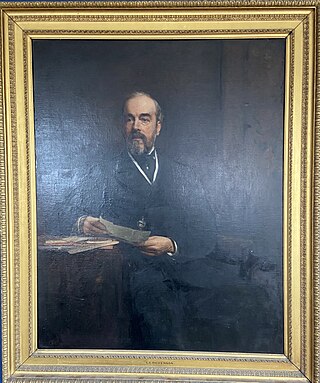
Lucas Brothers was a leading British building business based in London.

Camp Concordia was a prisoner-of-war camp that operated from 1943–1945. Its location is two miles north and one mile east of Concordia, Kansas. The camp was used primarily for German Army prisoners during World War II who were captured in battles that took place in Africa.

Ardenne Castle or the Royal Castle of Ardenne was a former residence and summer retreat of the Belgian royal family situated in the municipality of Houyet, Namur Province, Wallonia. It served as a luxury hotel from 1891 to 1949 and burned down in 1969.
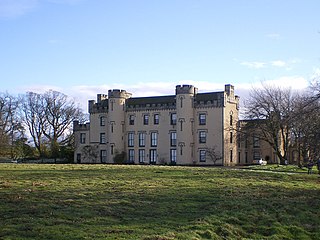
The House of the Binns, or simply the Binns, is a historic house in West Lothian, Scotland, the seat of the Dalyell family. It dates from the early 17th century, and was the home of Tam Dalyell until his death in January 2017.

Beauport Park is a house near Hastings, East Sussex, England. It is located at the western end of the ridge of hills sheltering Hastings from the north and east.

Firle Place is a Manor house in Firle, Sussex, United Kingdom. The Gage family have owned the land at Firle since acquiring it from the Levett family in the 15th century. The manor house was first built in the late 15th century by Sir John Gage, who made Firle Place his principal home. He held many high offices, including Constable of the Tower and was an executor of Henry VIII's will.
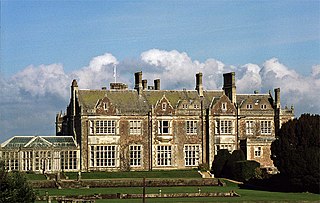
Wiston House is a 16th-century Grade I listed building set in the South Downs National Park on the south coast of England, surrounded by over 6,000 acres (2,400 ha) of parkland in Wiston, West Sussex. It is the home of Wilton Park, an executive agency of the Foreign and Commonwealth Office.

Hove Town Hall is the headquarters of Brighton and Hove City Council. The current building was constructed in 1970 in the Brutalist style by John Wells-Thorpe, to replace the original 1882 Hall which was damaged by fire in 1966.
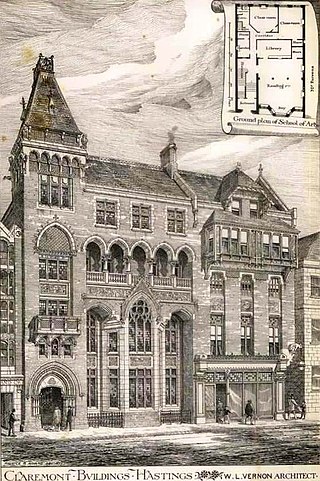
The Brassey Institute at 13 Claremont in Hastings, England, was founded by Thomas Brassey in 1879 and, as the Brassey School of Science and Art, provided for the study of arts and the sciences. It opened a chemistry laboratory in the Old Town of Hastings around 1900. The building has housed the town's library for decades. Stocking 11,000 volumes as of 1933, the Institute also housed a museum devoted to natural history, archaeology and local art.
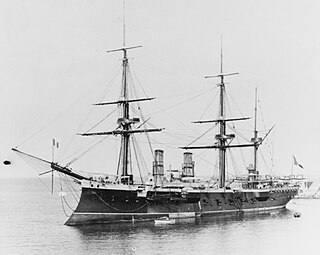
Sfax was a protected cruiser built for the French Navy in the 1880s. She was the first vessel of the type to be built for the French Navy, which was a development from earlier unprotected cruisers like Milan. Unlike the earlier vessels, Sfax carried an armor deck that covered her propulsion machinery and ammunition magazines. Intended to be used as a commerce raider in the event of war with Great Britain, Sfax was rigged as a barque to supplement her engines on long voyages abroad. She was armed with a main battery of six 164 mm (6.5 in) guns and a variety of lighter weapons.